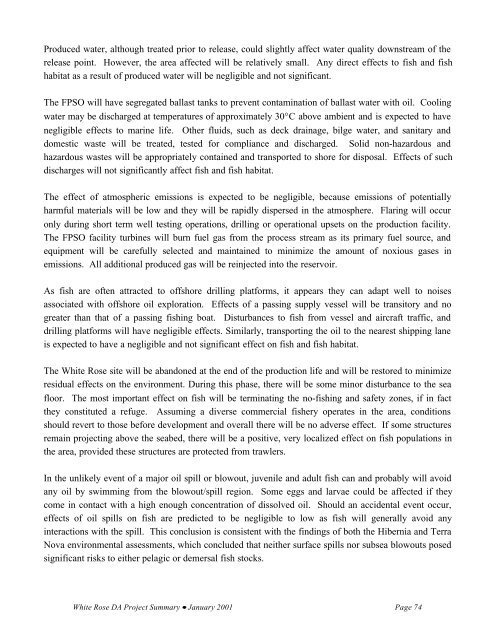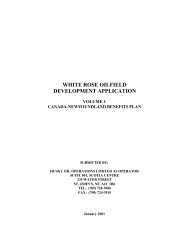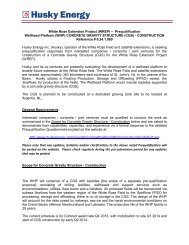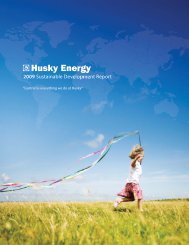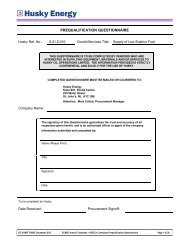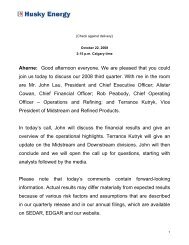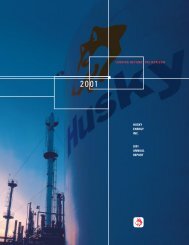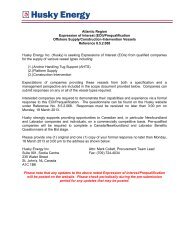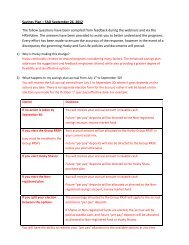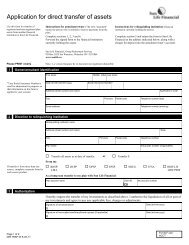white rose oilfield development application - Husky Energy
white rose oilfield development application - Husky Energy
white rose oilfield development application - Husky Energy
- No tags were found...
You also want an ePaper? Increase the reach of your titles
YUMPU automatically turns print PDFs into web optimized ePapers that Google loves.
Produced water, although treated prior to release, could slightly affect water quality downstream of therelease point. However, the area affected will be relatively small. Any direct effects to fish and fishhabitat as a result of produced water will be negligible and not significant.The FPSO will have segregated ballast tanks to prevent contamination of ballast water with oil. Coolingwater may be discharged at temperatures of approximately 30°C above ambient and is expected to havenegligible effects to marine life. Other fluids, such as deck drainage, bilge water, and sanitary anddomestic waste will be treated, tested for compliance and discharged. Solid non-hazardous andhazardous wastes will be appropriately contained and transported to shore for disposal. Effects of suchdischarges will not significantly affect fish and fish habitat.The effect of atmospheric emissions is expected to be negligible, because emissions of potentiallyharmful materials will be low and they will be rapidly dispersed in the atmosphere. Flaring will occuronly during short term well testing operations, drilling or operational upsets on the production facility.The FPSO facility turbines will burn fuel gas from the process stream as its primary fuel source, andequipment will be carefully selected and maintained to minimize the amount of noxious gases inemissions. All additional produced gas will be reinjected into the reservoir.As fish are often attracted to offshore drilling platforms, it appears they can adapt well to noisesassociated with offshore oil exploration. Effects of a passing supply vessel will be transitory and nogreater than that of a passing fishing boat. Disturbances to fish from vessel and aircraft traffic, anddrilling platforms will have negligible effects. Similarly, transporting the oil to the nearest shipping laneis expected to have a negligible and not significant effect on fish and fish habitat.The White Rose site will be abandoned at the end of the production life and will be restored to minimizeresidual effects on the environment. During this phase, there will be some minor disturbance to the seafloor. The most important effect on fish will be terminating the no-fishing and safety zones, if in factthey constituted a refuge. Assuming a diverse commercial fishery operates in the area, conditionsshould revert to those before <strong>development</strong> and overall there will be no adverse effect. If some structuresremain projecting above the seabed, there will be a positive, very localized effect on fish populations inthe area, provided these structures are protected from trawlers.In the unlikely event of a major oil spill or blowout, juvenile and adult fish can and probably will avoidany oil by swimming from the blowout/spill region. Some eggs and larvae could be affected if theycome in contact with a high enough concentration of dissolved oil. Should an accidental event occur,effects of oil spills on fish are predicted to be negligible to low as fish will generally avoid anyinteractions with the spill. This conclusion is consistent with the findings of both the Hibernia and TerraNova environmental assessments, which concluded that neither surface spills nor subsea blowouts posedsignificant risks to either pelagic or demersal fish stocks.White Rose DA Project Summary • January 2001 Page 74


